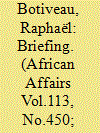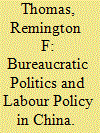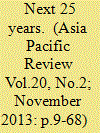|
|
|
Sort Order |
|
|
|
Items / Page
|
|
|
|
|
|
|
| Srl | Item |
| 1 |
ID:
131835


|
|
|
|
|
| Publication |
2014.
|
| Summary/Abstract |
MORE THAN A YEAR AFTER the South African police killed 34 strikers in Marikana, labour unrest continues across the country's mining sector. Industrial actions have targeted platinum giants like Amplats, the world's largest producer, where an 11-day strike over planned retrenchments has just ended and another is looming amid fresh wage talks. Rivalry between the National Union of Mineworkers (NUM) - aligned with the African National Congress (ANC) - and the more recent and militant Association of Mineworkers and Construction Union (AMCU) has also plagued the industry. On 17 October, an NUM branch chairperson at Lonmin - the third largest platinum producer in the world - was shot dead. Another Lonmin NUM shaft steward died in a similar situation on 3 November. A few months ago a former NUM leader who had become the AMCU regional representative in Rustenburg was ambushed - one of several from both sides assassinated since the Marikana massacre. In other words, the 'Framework Agreement for a Sustainable Mining Industry', promoted by South African Deputy President Kgalema Motlanthe and signed by parties to the industry on 3 July 2013, has so far failed to restore peace to the mining sector in Africa's largest economy.
|
|
|
|
|
|
|
|
|
|
|
|
|
|
|
|
| 2 |
ID:
161974


|
|
|
|
|
| Summary/Abstract |
Historical institutionalism has demonstrated the value of close analysis of policymaking to illuminate the relationship between institutional change and policy outcomes. This article emphasises the importance of the institutional setting in which state agencies in an authoritarian regime shape the agenda for choice, resolve disagreements and implement decisions. It outlines a model of policymaking and policy implementation in the sphere of labour relations in China by examining these three issue areas: enforcement of labour contract legislation, technical and vocational education and training (TVET) and pension reform. In all three, policymaking reflects the interaction of state entities, with minimal participation by non-state actors. However, in China, more than in other post-communist countries, political authority is dispersed across state bodies with overlapping responsibilities and levels of the administrative hierarchy. As a result, new policy initiatives tend to be “layered” on top of older ones rather than displacing them, and implementation tends to be hampered by jurisdictional competition and diverging bureaucratic policy preferences. This pattern helps account for the pattern of incremental change and weak implementation.
|
|
|
|
|
|
|
|
|
|
|
|
|
|
|
|
| 3 |
ID:
126787


|
|
|
|
|
| Publication |
New Delhi, Vitasta Publishing Pvt Ltd, 2014.
|
| Description |
429p.Hbk
|
| Standard Number |
9788192535494
|
|
|
|
|
|
|
|
|
|
|
|
Copies: C:1/I:0,R:0,Q:0
Circulation
| Accession# | Call# | Current Location | Status | Policy | Location |
| 057566 | 330.150954/SIH 057566 | Main | On Shelf | General | |
|
|
|
|
| 4 |
ID:
128253


|
|
|
|
|
| Publication |
2013.
|
| Summary/Abstract |
Taking the opportunity of the twenty-fifth year anniversary, these proposals were compiled to present a view of the issues that must be addressed together with a vision of how Japanese people will live their lives in a vibrant Japan that is active on the world stage in 25 years' time. Here the effort has been to formulate an ideal national vision and to endeavor to achieve this vision without getting caught up in constraints of the current reality.
Included herein are the Charter and individual proposals. The Charter describes a vision of the country of Japan and the Japanese people. The Charter was written to clearly express a vision for Japan and the Japanese people. Furthermore, the individual proposals focus on 10 issues confronting contemporary Japan that need to be overcome. Specifically, Reverse Declining Birth Rate, Seniors Contributing to Society, Education Policy, Labor Policy, Science and Technology Policy, Energy Policy, Diplomacy and Security Policy, Fiscal/Social Security Policy, Political Reform, and Good Governance of an Aging Society: A Master Plan are the issues addressed in these proposals.
The past cannot be changed, but with a sense of purpose and action, the future can be transformed. It is we ourselves who build and create the future. In 25 years hence, as the Japanese people live in safety and comfort, filled with happiness, Japan can contribute to the international community by actively contributing to peace and prosperity around the world. That is the role that we hope Japan fulfills.
|
|
|
|
|
|
|
|
|
|
|
|
|
|
|
|
|
|
|
|
|